Architecture Optimization of Hybrid Electric Vehicles with Future High-Efficiency Engine
Abstract
:1. Introduction
2. Optimization of Gear Numbers for HEVs
2.1. Overview
2.2. Modeling Process
2.2.1. Vehicle Mathematic Model
2.2.2. Engine Mathematic Model
2.2.3. Motor Mathematic Model
2.2.4. Battery Mathematic Model
2.3. Dynamic Programming
2.4. Simulation and Results
- Considering the utilization rate of each gear (the vehicle has less opportunities to work under lower gear states), the ratios between adjacent gears satisfy: , where is the ith gear ratio.
- The highest and lowest gear ratios are selected to satisfy the vehicle driving performance, that is, the maximum speed can be reached when the vehicle is driving under the highest gear; the vehicle can drive under the maximum grade when it is under the lowest gear.
- As can be seen from the first subplots of these two figures, for the conventional engine, only parts of the operating points are located in the fuel economy area. However, for the future engine with the extended fuel economy area, through the appropriate selection of gear ratios, most engines working points fall in the fuel economy area, thus increasing the working efficiency of the engine.
- For the whole NEDC driving cycle, the fuel consumption of the conventional engine under four gear transmission is 477 g, while for the future engine, the result is about 342 g, illustrating a great fuel consumption improvement.
- The engine and the motor could work in a coordinated manner to supply the required torque. The value of the battery is closely related to the vehicle condition (required speed and torque) and the motor/generator conditions (output speed and torque), and the charge-sustaining condition could be achieved when finishing the whole driving cycle.
3. Working Modes and Gear Shift Process of the Proposed Powertrain
3.1. Working Modes
3.1.1. EV Mode
3.1.2. HEV Mode
3.2. Gear Shift Process
3.2.1. EV Mode
3.2.2. HEV Mode
4. Performance Validation of the Proposed Powertrain
4.1. Fuel Consumption
4.2. Gear Shift Quality
4.2.1. Gear Shift Process
4.2.2. Gear Shift Results
5. Conclusions
- According to the massive studies, advanced technologies and developments, a future engine model with better thermal efficiency and extended fuel economy area is set up.
- The relation between the future engine and the gearbox gear numbers are explored, and the simulation results indicate that for the HEVs, the gearbox with only four gears can satisfy the driving demand and the future engine shows a better performance of fuel consumption compared with the conventional engine.
- Based on the simulation results, a new powertrain architecture is introduced which can supply four gears for the engine operating condition and two gears for the motor operating condition. Besides, one highlight of this powertrain architecture is the gear shift process which can be achieved without power interruption.
- The fuel consumption and gear shift process of this new powertrain architecture are simulated in the AMESim software, and the simulation results demonstrate that the fuel consumption for a 1.8 t vehicle operating under the charge-sustaining condition is 4.30 L/100 km. In addition, the gear shift process in the EV mode and HEV mode can be completed without power interruption and the maximum jerk are 1.66 m/s3 and 2.12 m/s3, respectively.
Author Contributions
Acknowledgments
Conflicts of Interest
References
- Solouk, A.; Shahbakhti, M. Energy Optimization and Fuel Economy Investigation of a Series Hybrid Electric Vehicle Integrated with Diesel/RCCI Engines. Energies 2016, 9, 1020. [Google Scholar] [CrossRef]
- Al-Alawi, B.M.; Bradley, T.H. Review of hybrid plug-inhybrid and electric vehicle market modeling Studies. Renew. Sustain. Energy Rev. 2013, 21, 190–203. [Google Scholar] [CrossRef]
- Hannan, M.A.; Azidin, F.A.; Mohamed, A. Hybrid electric vehicles and their challenges: A review. Renew. Sustain. Energy Rev. 2014, 29, 135–150. [Google Scholar] [CrossRef]
- Pisu, P.; Rizzoni, G. A Comparative Study Of Supervisory Control Strategies for Hybrid Electric Vehicles. IEEE Trans. Control Syst. Technol. 2007, 15, 506–518. [Google Scholar] [CrossRef]
- Feng, R.H.; Li, Y.T.; Yang, J.; Fu, J.Q.; Zhang, D.M.; Zheng, G.Z. Investigations of Atkinson Cycle Converted from Conventional Otto Cycle Gasoline Engine. SAE Tech. Pap. 2016. [Google Scholar] [CrossRef]
- Pertl, P.; Trattner, A.; Abis, A.; Schmidt, S.; Kirchberger, R.; Sato, T. Expansion to Higher Efficiency— Experimental Investigations of the Atkinson Cycle in Small Combustion Engines. SAE Tech. Pap. 2012. [Google Scholar] [CrossRef]
- Ikeya, K.; Takazawa, M.; Yamada, T.; Park, S.; Tagishi, R. Thermal Efficiency Enhancement of a Gasoline Engine. SAE Int. J. Engines 2015, 8, 1579–1586. [Google Scholar] [CrossRef]
- Yonekawa, A.; Ueno, M.; Watanabe, O.; Ishikawa, N. Development of New Gasoline Engine for ACCORD Plug-in Hybrid. SAE Tech. Pap. 2013. [Google Scholar] [CrossRef]
- Hwang, K.; Hwang, I.; Lee, H.; Park, H.; Choi, H.; Lee, K.; Kim, W.; Kim, H.; Han, B.; Lee, J.; et al. Development of New High-Efficiency Kappa 1.6 L GDI Engine. SAE Tech. Pap. 2016. [Google Scholar] [CrossRef]
- Yamada, T.; Adachi, S.; Nakata, K.; Kurauchi, T.; Takagi, I. Economy with superior thermal efficient combustion (ESTEC). SAE Tech. Pap. 2014. [Google Scholar] [CrossRef]
- Nakata, K.; Nogawa, S.; Takahashi, D.; Yoshihara, Y.; Kumagai, A.; Suzuki, T. Engine technologies for achieving 45% thermal efficiency of SI engine. SAE Int. J. Engines 2016. [Google Scholar] [CrossRef]
- Solouk, A.; Shahbakhti, M.; Mahjoob, M.J. Energy Management and Control of a Hybrid Electric Vehicle With an Integrated Low Temperature Combustion (LTC) Engine. Dyn. Syst. Control 2014. [Google Scholar] [CrossRef]
- Solouk, A.; Shahbakhti, M. Modeling and energy management of an HCCI-based powertrain for series hybrid and extended range electric vehicles. Int. J. Powertrains 2017, 6, 1–33. [Google Scholar] [CrossRef]
- Hanson, R.; Spannbauer, S.; Gross, C.; Reitz, R.D.; Curran, S.; Storey, J.; Huff, S. Highway Fuel Economy Testing of an RCCI Series Hybrid Vehicle. SAE Tech. Pap. 2015. [Google Scholar] [CrossRef]
- Solouk, A.; Shakiba-herfeh, M.; Kannan, K.; Solmaz, H.; Dice, P.; Bidarvatan, M.; Kondipati, N.N.T.; Shahbakhti, M. Fuel Economy Benefits of Integrating a Multi-Mode Low Temperature Combustion (LTC) Engine in a Series Extended Range Electric Powertrain. SAE Tech. Pap. 2016. [Google Scholar] [CrossRef]
- Nuesch, S.; Stefanopoulou, A.G. Multimode combustion in a mild hybrid electric vehicle. Part 1: Supervisory control. Control Eng. Pract. 2016, 57, 99–110. [Google Scholar] [CrossRef]
- Solouk, A.; Shakiba-Herfeh, M.; Shahbakhti, M. Analysis and control of a torque blended hybrid electric powertrain with a multi-mode LTC-SI engine. SAE Int. J. Altern. Powertrains 2017, 6, 54–67. [Google Scholar] [CrossRef]
- Solouk, A.; Shakiba-Herfeh, M.; Arora, J.; Shahbakhti, M. Fuel consumption assessment of an electrified powertrain with a multi-mode high-efficiency engine in various levels of hybridization. Energy Convers. Manag. 2017, 155, 100–115. [Google Scholar] [CrossRef]
- Zhang, L.P.; Qi, B.N.; Zhang, R.S.; Liu, J.C.; Wang, L.Q. Powertrain design and energy management of a novel coaxial series-parallel plug-in hybrid electric vehicle. Sci. China Technol. Sci. 2016, 59, 618–630. [Google Scholar] [CrossRef]
- Guzzella, L.; Sciarretta, A. Vehicle Propulsion Systems; Springer: Berlin/Heidelberg, Germany; New York, NY, USA, 2007; pp. 73–77. ISBN 978-3-540-74691-1. [Google Scholar]
- Williamson, S.S. Energy Management Strategies for Electric and Plug-in Hybrid Electric Vehicles; Springer: New York, NY, USA, 2013; pp. 7–13. ISBN 9781461477105. [Google Scholar]
- Jager, B.; Keulen, T.; Kessels, J. Optimal Control of Hybrid Vehicle; Springer: Berlin, Germany, 2013; pp. 1–12. ISBN 978-1-4471-5075-6. [Google Scholar]
- Jauch, C.; Tamilarasan, S.; Bovee, K.; Guvenc, L.; Rizzoni, G. Modeling for drivability and drivability improving control of HEV. Control Eng. Pract. 2018, 70, 50–62. [Google Scholar] [CrossRef]
- Johnson, V.H.; Wipke, K.B.; Rausen, D.J. HEV Control Strategy for Real-Time Optimization of Fuel Economy and Emissions. Mccarthy 2000. [Google Scholar] [CrossRef]
- Walker, A.; McGordon, A.; Hannis, G.; Picarelli, A.; Breddy, J.; Carter, S.; Vinsome, A.; Jennings, P.; Dempsey, M.; Willows, M. A Novel Structure for Comprehensive HEV Powertrain Modelling. In Proceedings of the 2006 IEEE Vehicle Power and Propulsion Conference, VPPC 2006, Windsor, UK, 6–8 September 2006; pp. 1–5. [Google Scholar]
- Conlon, B.M.; Blohm, T.; Harpster, M.; Holmes, A.; Palardy, M.; Tarnowsky, S.; Zhou, L. The Next Generation “Voltec” Extended Range EV Propulsion System. SAE Int. J. Altern. Powertrains 2015, 4, 248–259. [Google Scholar] [CrossRef]
- Higuchi, N.; Sunaga, Y.; Tanaka, M.; Shimada, H. Development of a New Two-Motor Plug-In Hybrid System. SAE Int. J. Altern. Powertrains 2013, 2, 135–145. [Google Scholar] [CrossRef]
- Hofman, T.; Ebbesen, S.; Guzzella, L. Topology optimization for hybrid electric vehicles with automated transmissions. IEEE Trans. Veh. Technol. 2012, 61, 2442–2451. [Google Scholar] [CrossRef]
- Delorme, A.; Rousseau, A.; Wallner, T.; Ortiz-Soto, E.A.; Babajimopoulos, A.; Assanis, D.N. Evaluation of homogeneous charge compression ignition (HCCI) engine fuel savings for various electric drive powertrains. In Proceedings of the The 25th World Battery, Hybrid and Fuel Cell Electric Vehicle Symposium & Exhibition, Shenzhen, China, 5–9 Noverber 2010. [Google Scholar]
- Lawler, B.; Ortiz-Soto, E.; Gupta, R.; Peng, H.; Filipi, Z.S. Hybrid Electric Vehicle Powertrain and Control Strategy Optimization to Maximize the Synergy with a Gasoline HCCI Engine. SAE Int. J. Engines 2011, 4, 1115–1126. [Google Scholar] [CrossRef]
- Robinette, D.L.; Wehrwein, D. Automatic Transmission Gear Ratio Optimization and Monte Carlo Simulation of Fuel Consumption with Parasitic Loss Uncertainty. SAE Int. J. Commer. Veh. 2015, 8, 45–62. [Google Scholar] [CrossRef]
- Robinette, D.L.; Singh, T. Internal Combustion Engine—Automatic Transmission Matching for Next Generation Power Transfer Technology Development in Automotive Applications. SAE Int. J. Engines 2016, 9, 1863–1880. [Google Scholar] [CrossRef]
- Sellnau, M.C.; Sinnamon, J.; Hoyer, K.; Kim, J.; Cavotta, M.; Husted, H. Part-Load Operation of Gasoline Direct-Injection Compression Ignition (GDCI) Engine. Sae Tech. Pap. 2013, 2, 29–38. [Google Scholar]
- Zhao, L.C.; Gao, B.Z.; Wu, J.Z.; Chen, H. Optimization of gear number for hybrid electric vehicles using dynamic programming. In Proceedings of the 2017 Chinese Automation Congress (CAC), Jinan, China, 20–22 October 2017; pp. 6646–6650. [Google Scholar]
- Solouk, A.; Tripp, J.; Shakiba-Herfeh, M.; Shahbakhti, M. Fuel consumption assessment of a multi-mode low temperature combustion engine as range extender for an electric vehicle. Energy Convers. Manag. 2017, 148, 1478–1496. [Google Scholar] [CrossRef]
- Nüesch, T.; Elbert, P.; Flankl, M.; Onder, C.; Guzzella, L. Convex Optimization for the Energy Management of Hybrid Electric Vehicles Considering Engine Start and Gearshift Costs. Energies 2014, 7, 834–856. [Google Scholar] [CrossRef]
- Elbert, P.; Ebbesen, S.; Guzzella, L. Implementation of Dynamic Programming for n-Dimensional Optimal Control Problems with Final State Constraints. IEEE Trans. Control Syst. Technol. 2013, 21, 924–931. [Google Scholar] [CrossRef]
- Wang, X.; He, H.; Sun, F.; Zhang, J. Application Study on the Dynamic Programming Algorithm for Energy Management of Plug-in Hybrid Electric Vehicles. Energies 2015, 8, 3225–3244. [Google Scholar] [CrossRef]
- Chen, H.; Gao, B.; Guo, L.; Liang, Q.; Xiang, Y. Hybrid Power Driving Device for Vehicle and Control Method Thereof. U.S. Patent US9370993B2, 12 March 2014. [Google Scholar]
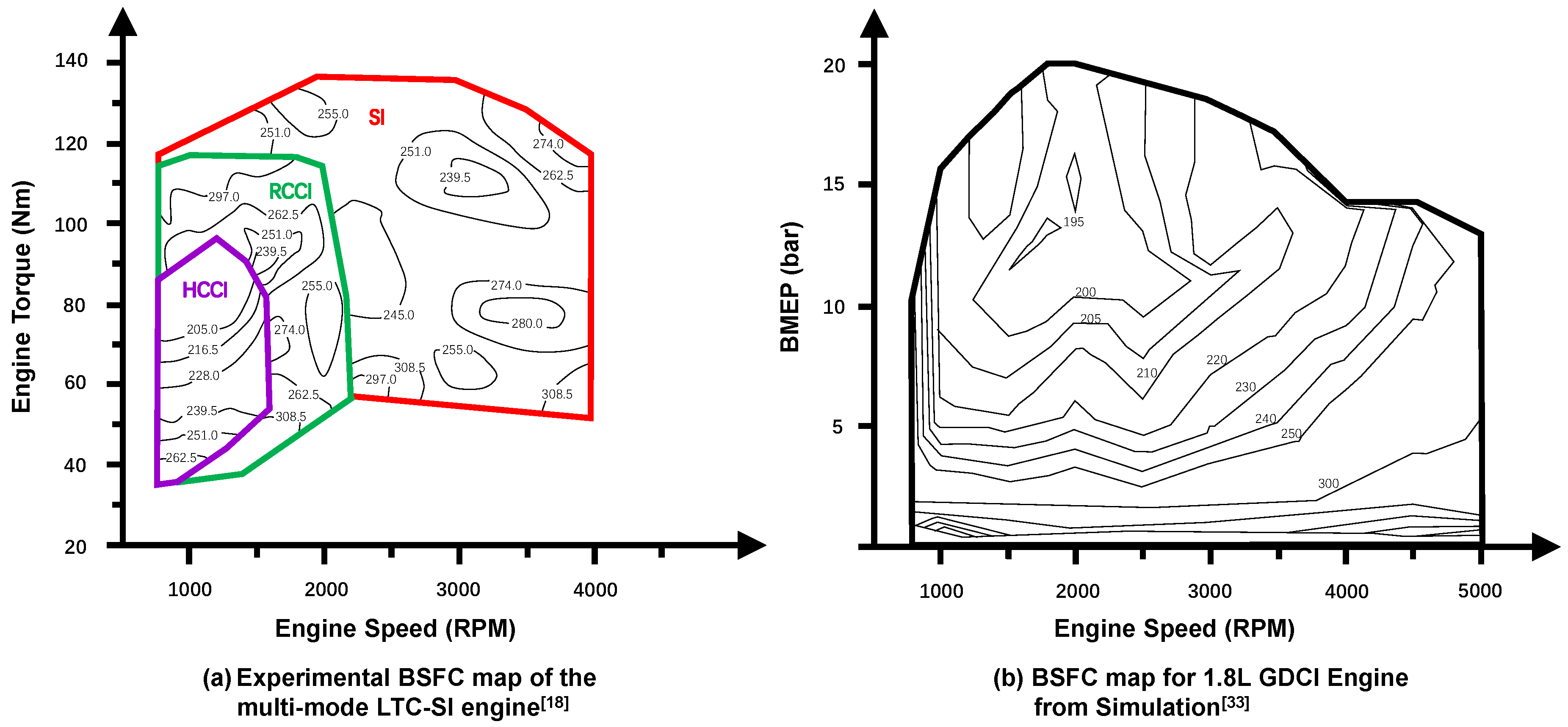
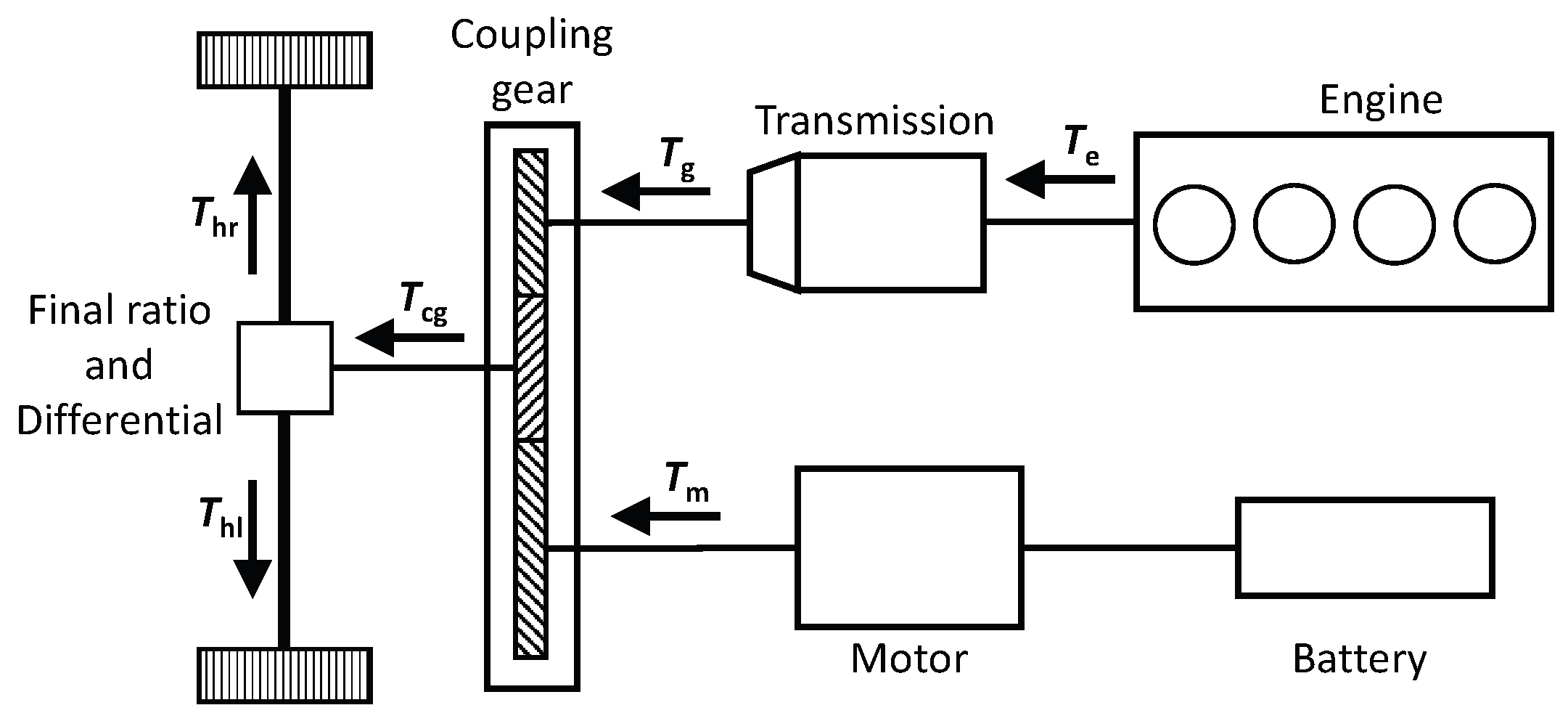
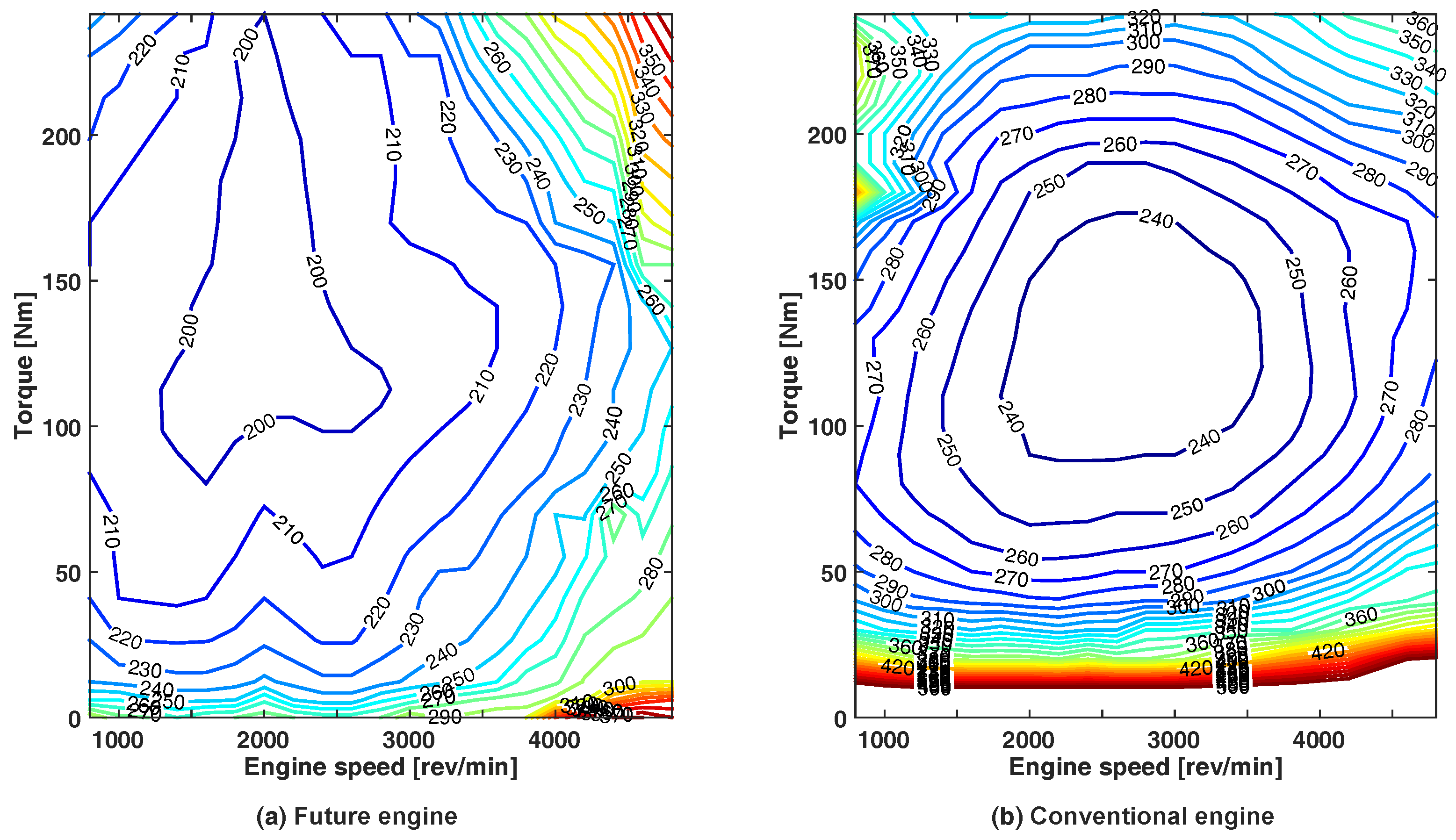
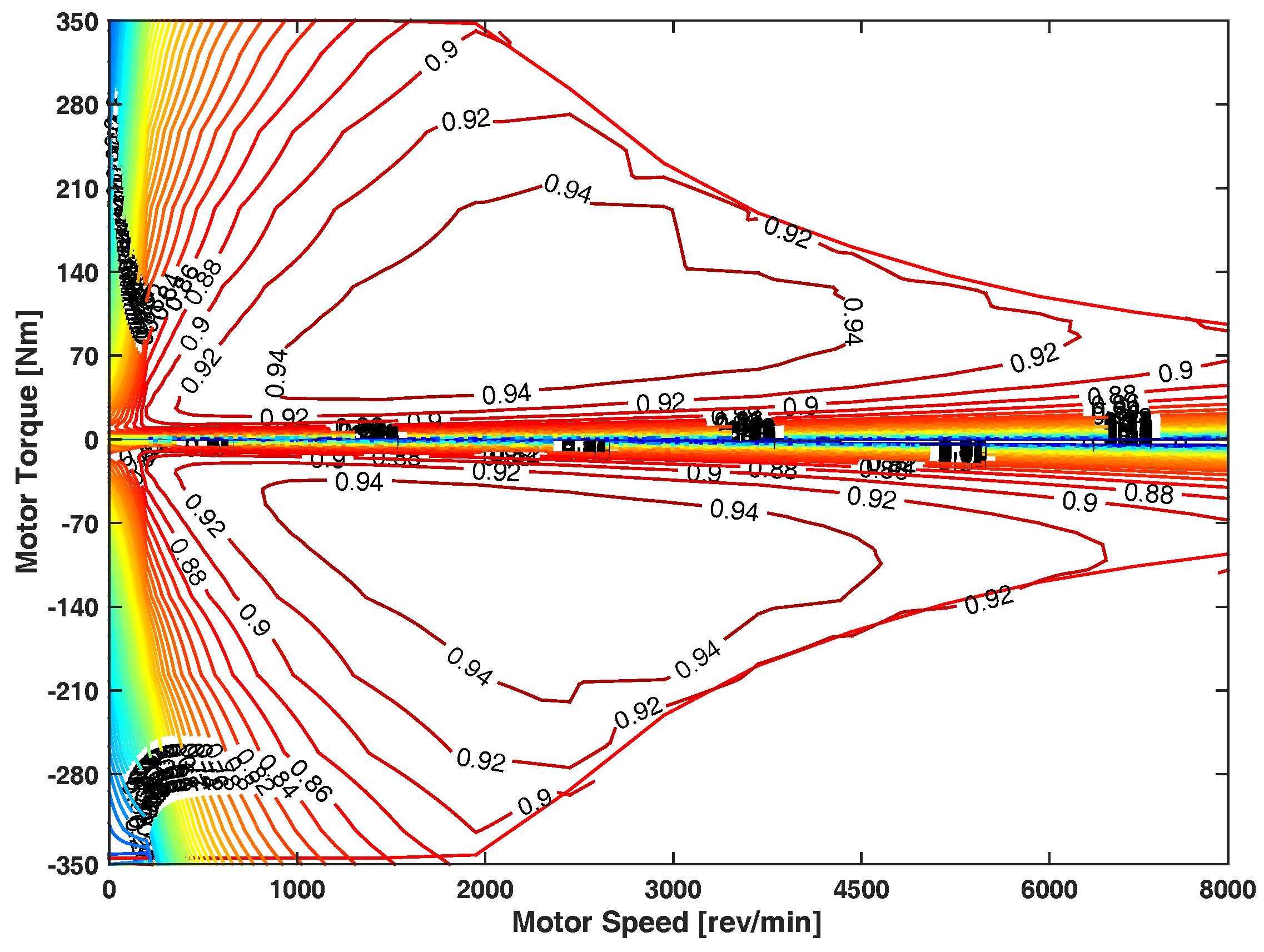
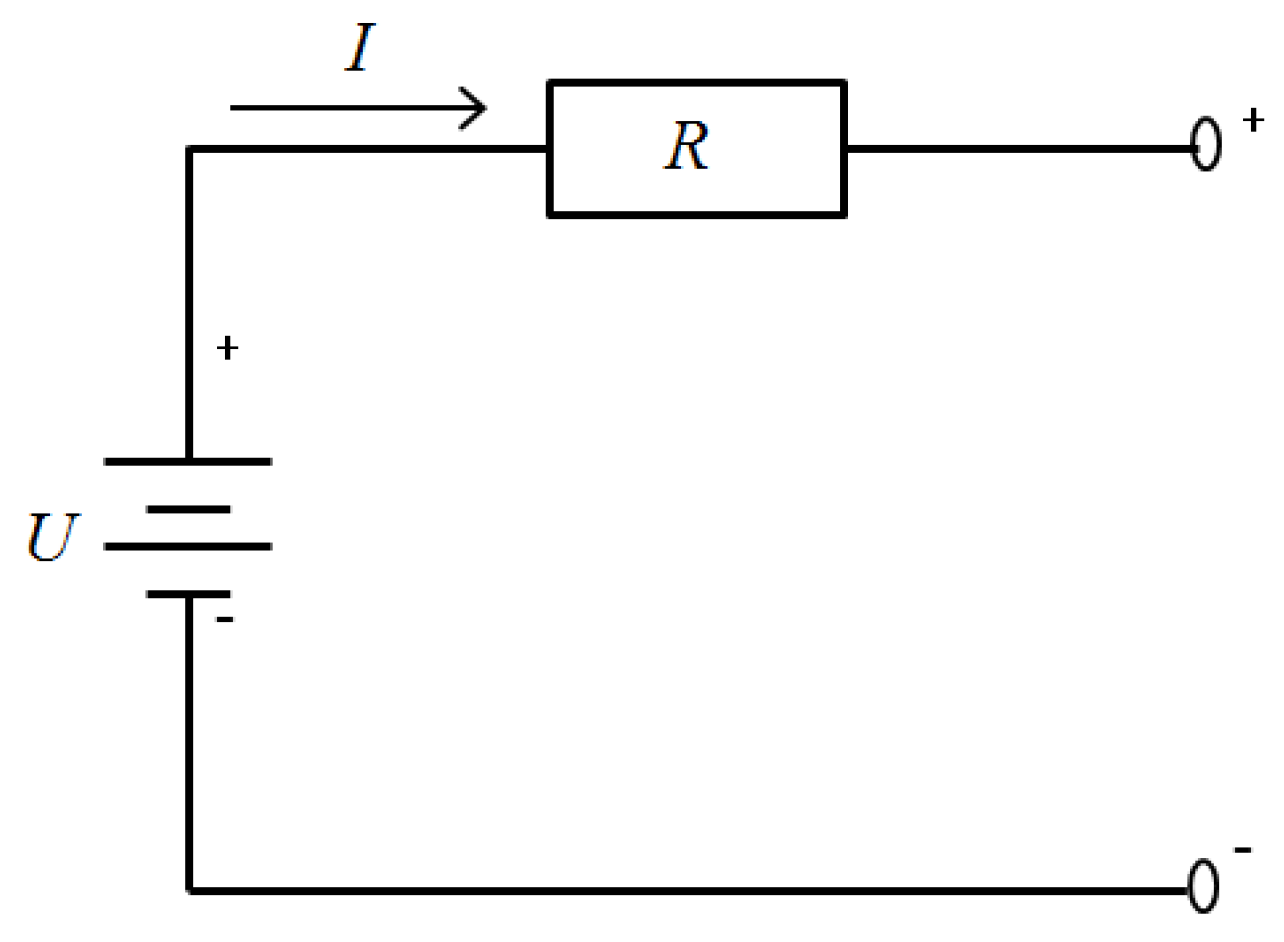
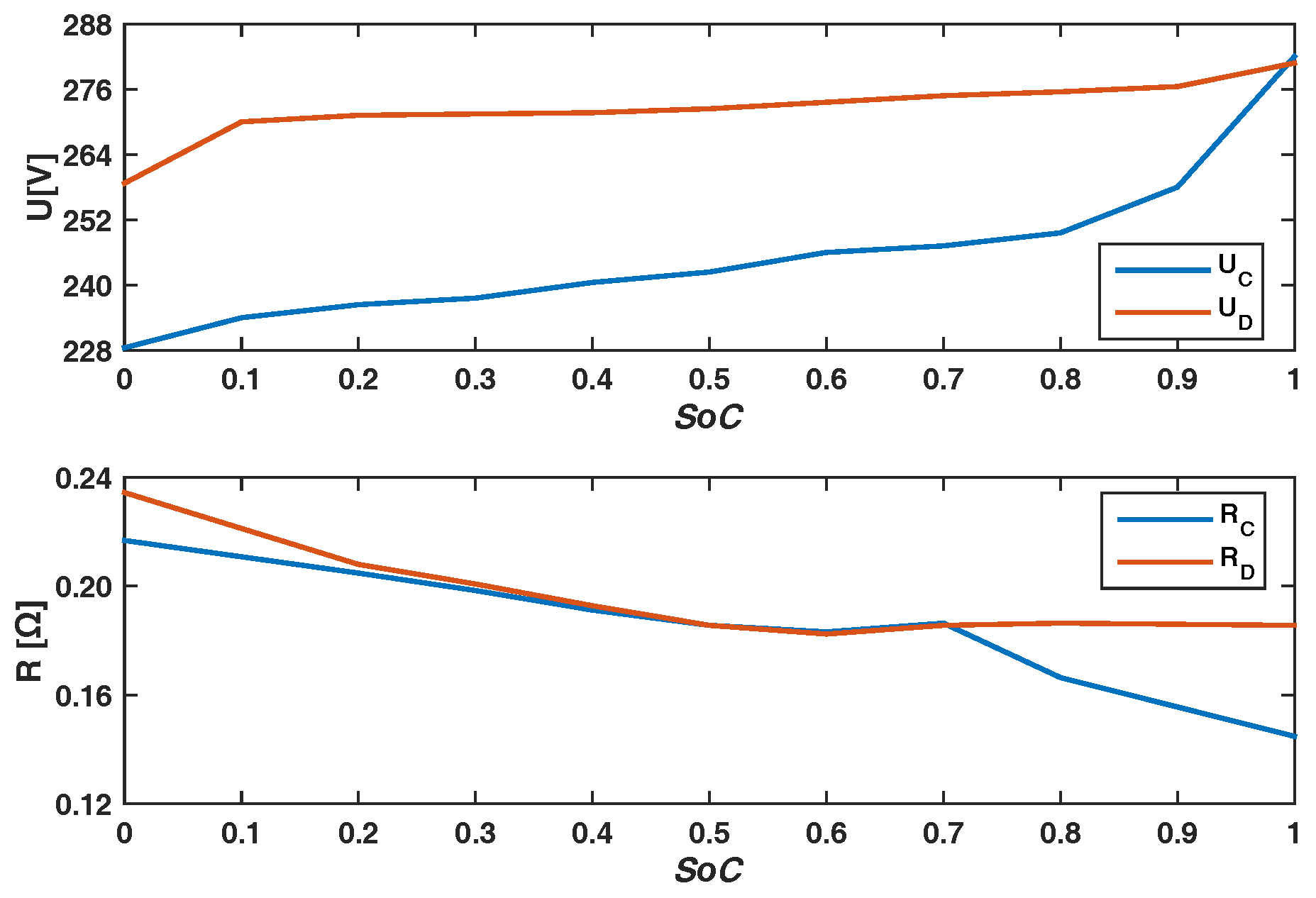
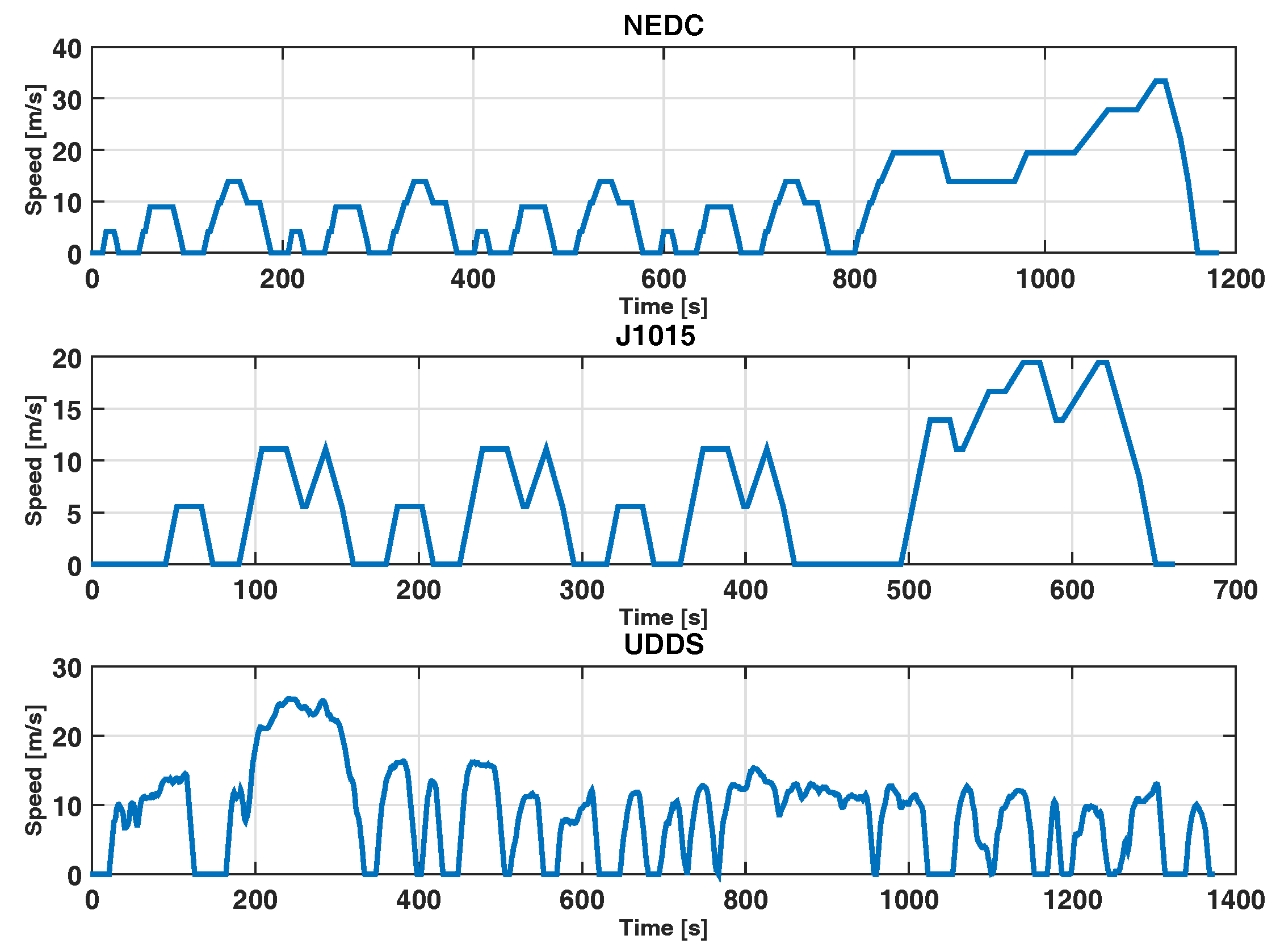
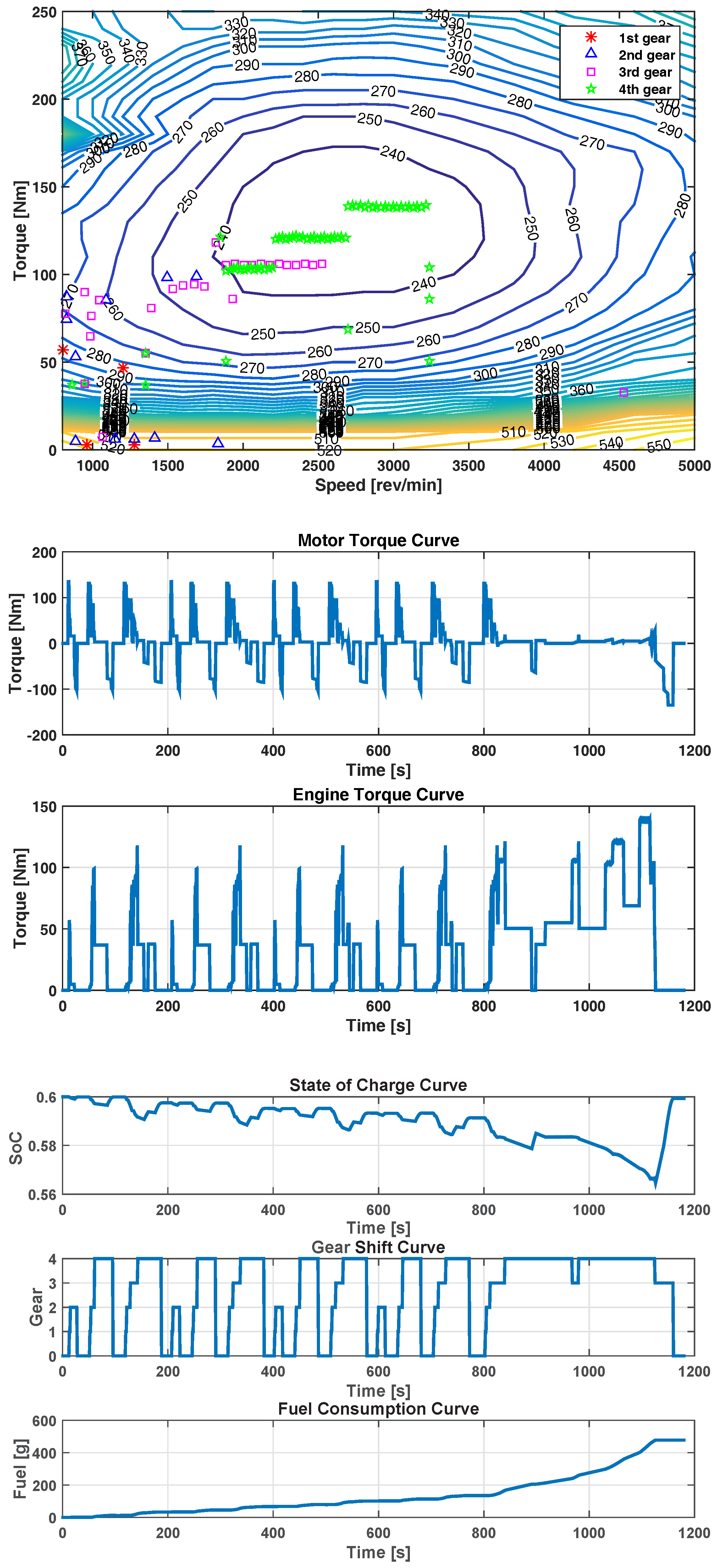
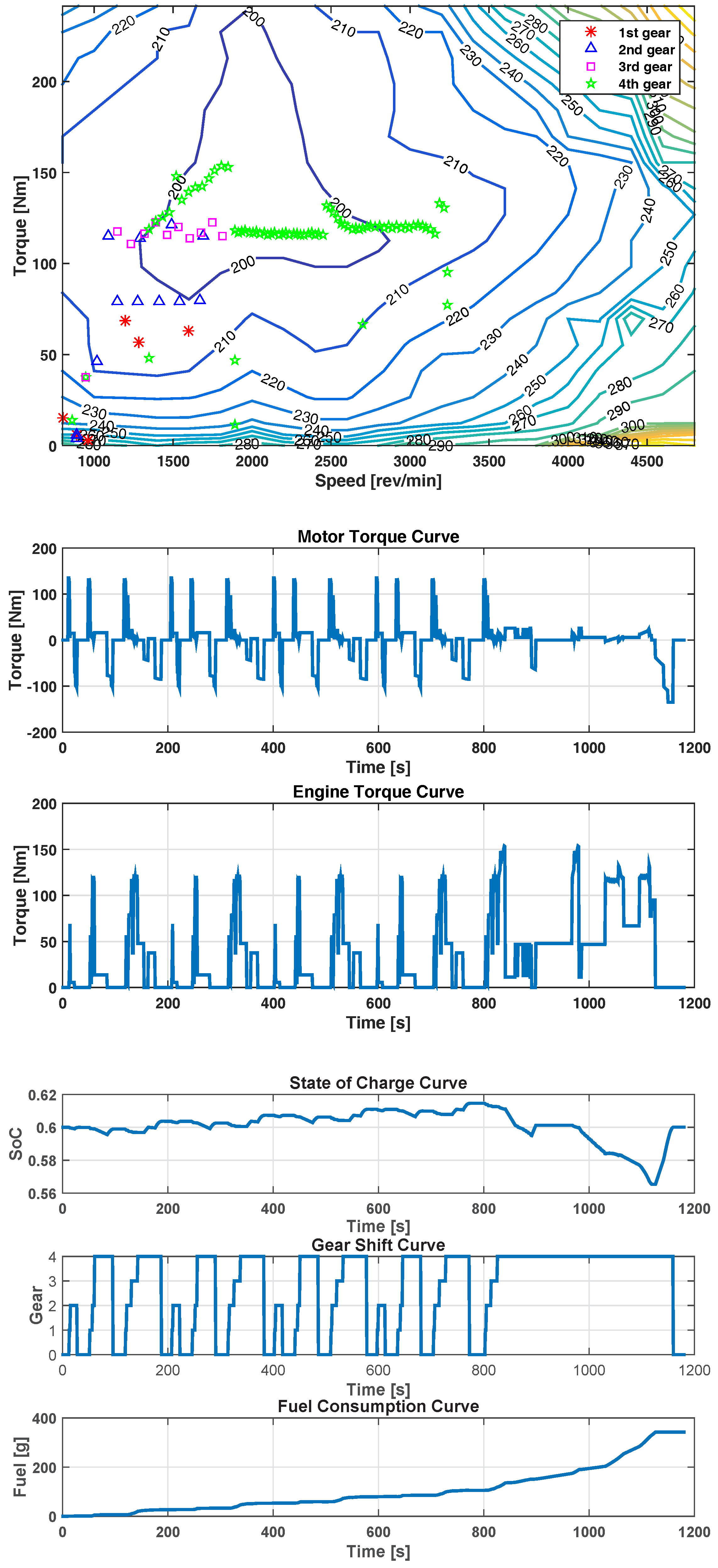

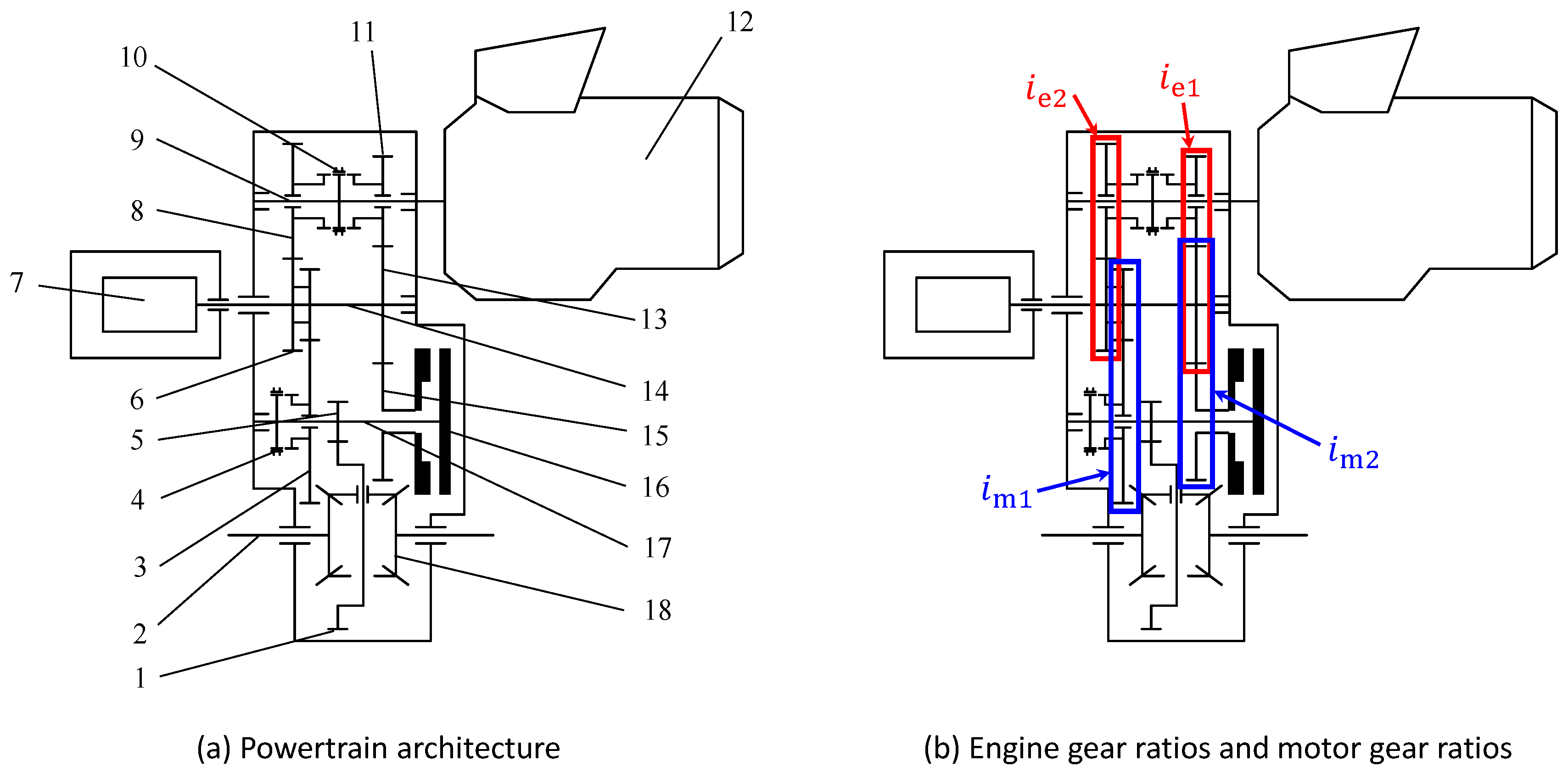




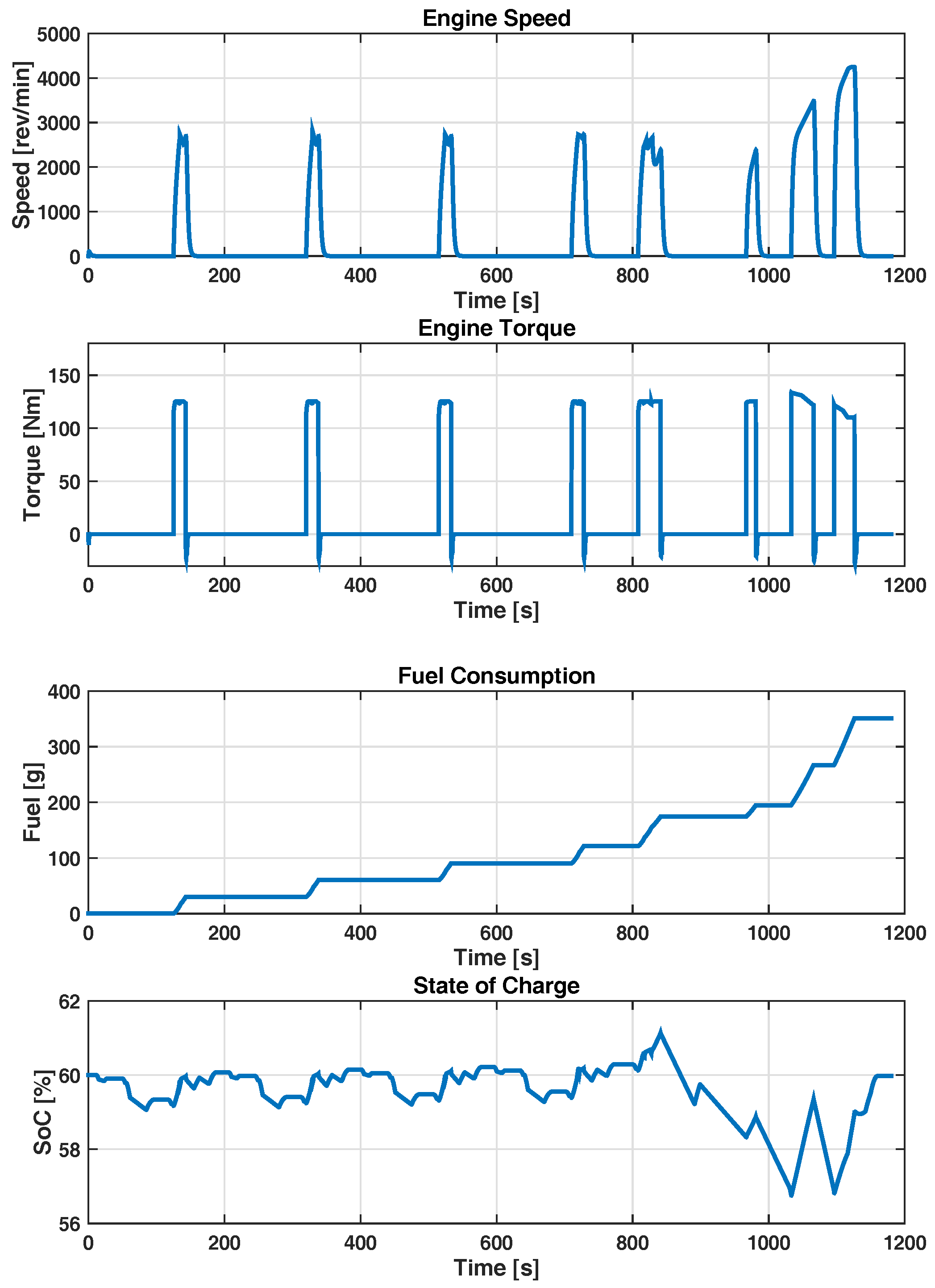
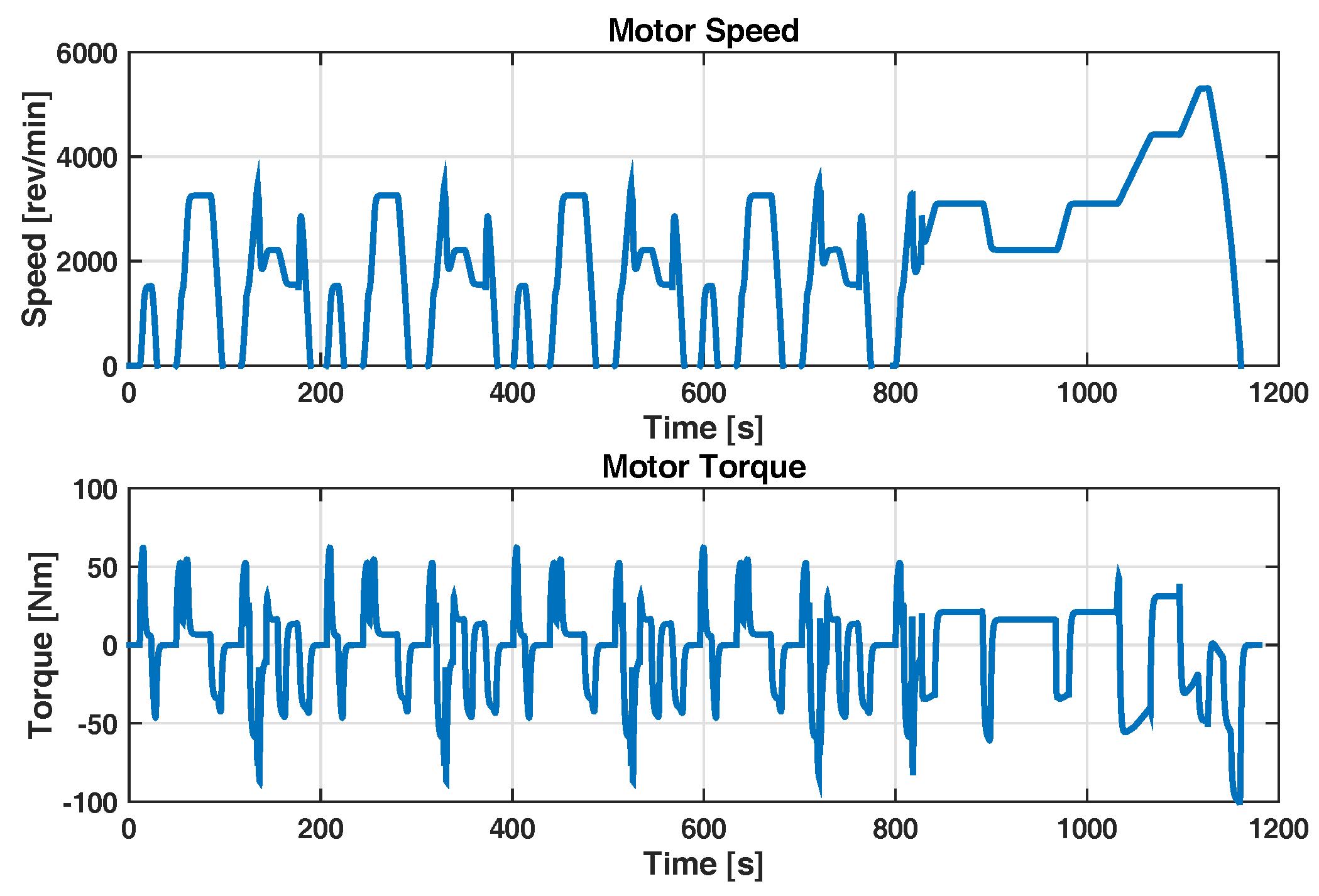
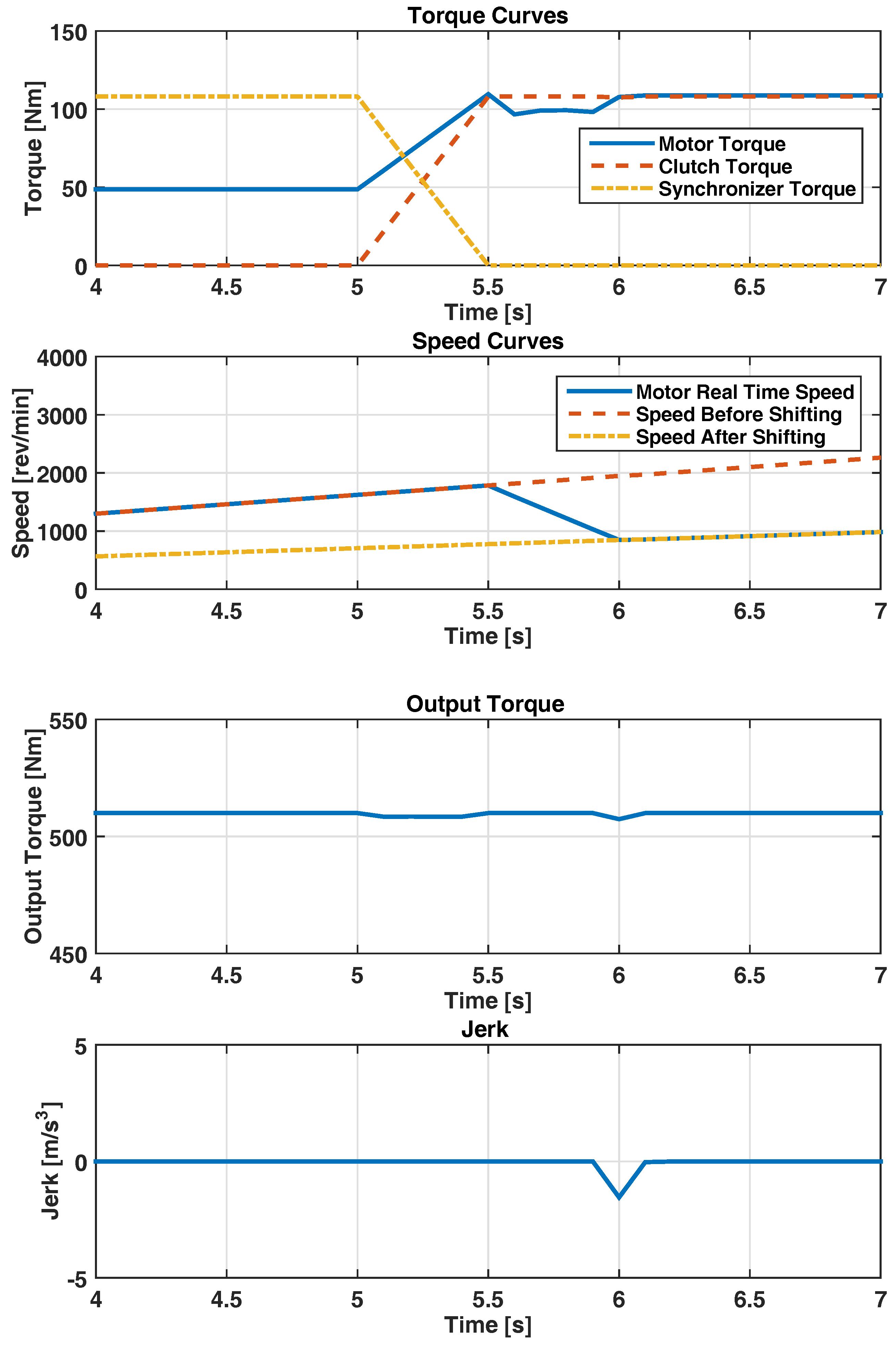
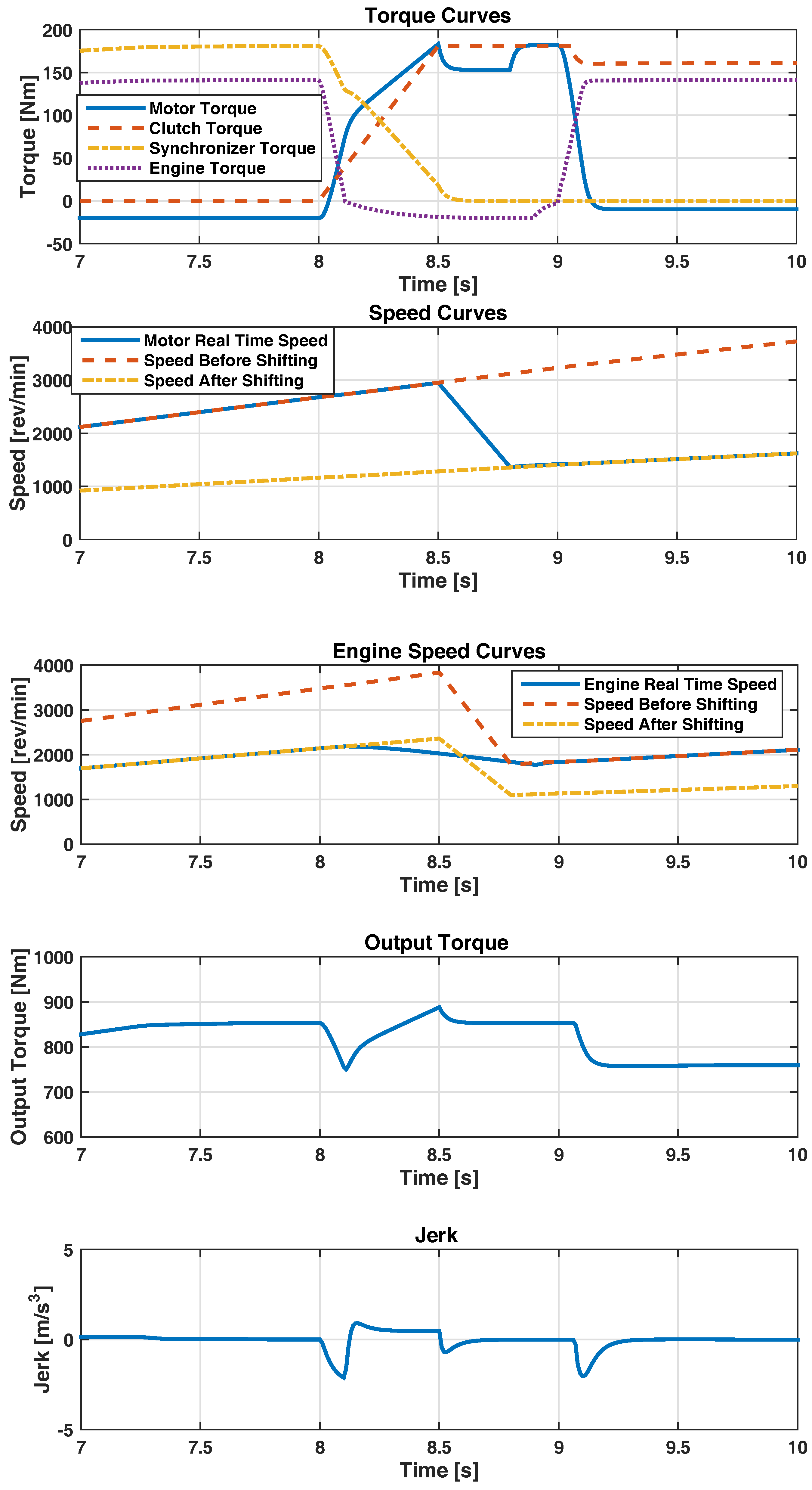
| Vehicle | ||
|---|---|---|
| m | Vehicle gross mass | 1800 (kg) |
| r | Tire radius | 0.37 (m) |
| S | Face area | 2.10 (m2) |
| Rotational mass coefficient | 1.2 | |
| Main reducer ratio | 4.235 | |
| f | Rolling resistance coefficient | 0.01 |
| Road gradient | 0 | |
| Air resistance coefficient | 0.32 | |
| Engine coupling ratio | 1 | |
| Motor coupling ratio | 1.5 | |
| Engine | ||
| Maximum engine speed | 5000 (rpm) | |
| Maximum engine power | 85 (Kw) | |
| Maximum engine torque | 241 (Nm) | |
| Motor | ||
| Maximum motor power | 70 (Kw) | |
| Maximum motor speed | 8000 (rpm) | |
| Maximum motor torque | 350 (Nm) | |
| Battery | ||
| C | Battery capacity | 19.5 (Ah) |
| Gear Numbers | Gear Ratios |
|---|---|
| Six Gears | 3.994 2.482 1.582 1.112 0.912 0.795 |
| Five Gears | 3.769 2.095 1.433 1.079 0.851 |
| Four Gears | 3.526 1.956 1.247 0.892 |
| Three Gears | 3.165 1.739 1.087 |
| Two Gears | 2.910 1.140 |
| Air density | 1.2 (kg·m3) | |
| Engine inertia | 0.15 (kg·m2) | |
| Maximum friction torque of the clutch | 350 (Nm) | |
| Inertia of motor output shaft | 0.015 (kg·m2) | |
| Damp of motor output shaft | 4.19 × 10−5 (Nm/(rad/s)) | |
| Inertia of one tire | 0.805 (kg·m2) |
© 2018 by the authors. Licensee MDPI, Basel, Switzerland. This article is an open access article distributed under the terms and conditions of the Creative Commons Attribution (CC BY) license (http://creativecommons.org/licenses/by/4.0/).
Share and Cite
Hong, J.; Zhao, L.; Lei, Y.; Gao, B. Architecture Optimization of Hybrid Electric Vehicles with Future High-Efficiency Engine. Energies 2018, 11, 1148. https://doi.org/10.3390/en11051148
Hong J, Zhao L, Lei Y, Gao B. Architecture Optimization of Hybrid Electric Vehicles with Future High-Efficiency Engine. Energies. 2018; 11(5):1148. https://doi.org/10.3390/en11051148
Chicago/Turabian StyleHong, Jinlong, Liangchun Zhao, Yulong Lei, and Bingzhao Gao. 2018. "Architecture Optimization of Hybrid Electric Vehicles with Future High-Efficiency Engine" Energies 11, no. 5: 1148. https://doi.org/10.3390/en11051148





